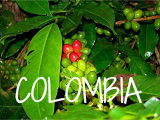COLOMBIA
Capital City: Bogotá
Population: 49,464,683
Other Major Cities: Medellín, Cali, Barranquilla, Cartagena, Cúcuta, Bucaramanga, Ibagué, Pereira, Santa Marta, Montería, Villavicencio, Manizales, Valledupar, Neiva, Armenia
Main Airport(s): Bogotá, Medellín, Cali, Barranquilla, Cartagena
Airlines: Avianca, COPA, and LATAM, with additional service by most larger carriers.
Visa requirements: No visa required for Australian, British, Canadian EU, and USA passport holders for stay of up to 90 days. A departure fee of $37 USD/$124,600 COP (as of 2/7/2016.)
Language: Spanish, with smaller populations speaking indigenous languages and Palenquero, an African-Spanish hybrid language.
Weather: It can vary greatly by region.
Currency: Colombian pesos
Train: There is no railroad in Colombia, save for the short touristic line that runs between Bogotá, Cajicá, and Zipaquirá, two villages north of the city.
Bus: Colombia has an extensive bus network that will take you to all major cities and even the smallest villages. Connections are available to other South American countries.
Car: It is generally not recommended that you drive. However, nearly all cars are manual.
Accommodation: The greatest range of lodging is found in larger cities, which range from hostels and budget hotels to luxury internationally recognized chains. You will usually find a hotel in even the smallest of villages, though quality and value may vary. Hostels have caught on in the past decade or so, giving budget travelers more options.
Hotel: The biggest variety of hotels are found in Bogotá, Medellín, and Cartagena, which are Colombia’s largest tourism hubs.
Budget: While somewhat scarce a decade ago, hostels are becoming increasingly popular here and are often better value than smaller budget hotel chains. A word of caution: the term motel has a different connotation in Colombia. These accommodations charge by the hour and clientele aren’t there for sightseeing!
Eating Out: Major cities have the best variety ranging from regional and typical Colombian dishes to international cuisine. Mexican, Italian, Thai, Chinese, and American are popular choices. In smaller cities and towns, get used to lots of rice, beans, chicken, and meat.
Nightlife: Like most countries in Latin America, sizable Colombian cities have zonas rosas, or party zones, with many options for eating, drinking, and dancing. Bogotá, Medellín, Cali, and Cartagena are known around the country for their dining and nightlife options. Cities like Barranquilla, Bucaramanga, and the smaller coffee region cities also have lively zonas rosas.
Connections (wifi): Most accommodations provide access to wifi. However, speed and reliability can vary greatly, with upmarket locales able to offer faster, more continuous service. Internet cafes are popular here, where you can check your e-mail and social media for a few dollars.
DID YOU KNOW?
Behind Brazil, Colombia has the highest diversity in the world. This is ode to Colombia’s six regions, which range from Amazonian rainforest to Caribbean desert and even a chilly Andean mountain region.
ECUADOR
Capital City: Quito
Population: 16,863,425
Other Major Cities: Guayaquil and Cuenca
Main Airports: Quito and Guayaquil
Visa requirements: Passport holders of the USA, Canada, Australia and the UK do not need a visa for stays up to 90 days.
Language: Spanish, Quechua, and several other indigenous languages.
Weather: Varies greatly by region.
Currency: The United States Dollar, though actual coins may differ in design the what you’d find in the USA.
Transportation:
- Train: The railroads in Ecuador serve primarily touristic purposes.
- Bus: Buses are the best way to travel around the country, which has a comprehensive network.
- Car: Not recommended, as roads tend to be very windy as you travel through mountainous and jungle regions. Most cars here are manual
Accommodation: Lodging in relatively cheap here and you can find a small hotel for under $50; lodging tends to be more expensive in Cuenca. Hostels are also catching on here. Stays in jungle lodges in the Amazon are also available.
Hotel: When in Quito, stay at Hotel San Francisco de Quito, a beautiful colonial building adorned with hanging plants, a short walk from Plaza San Francisco, one of the city’s many public squares. Splurge in Cuenca, which is known for its beautiful boutique hotels and bed and breakfasts. Hostels are available in many of the heavily touristed cities and villages for as little as $7 for a dorm bed. A private room in a hostel or small hotel can be had for under $20.
Eating Out: Ecuadorian food differs by region, with mountain cuisine rich in carbohydrates and meats, while its Pacific coastal regions feature fish and seafood. In the larger cities and towns, international food can be found, Chinese restaurants— known in Ecuador as a chifas — and pizza being very popular.
Nightlife: Quito and Cuenca have a large choice of bars and nightclubs, while coast towns like Montañita have open air cafes and bars.

